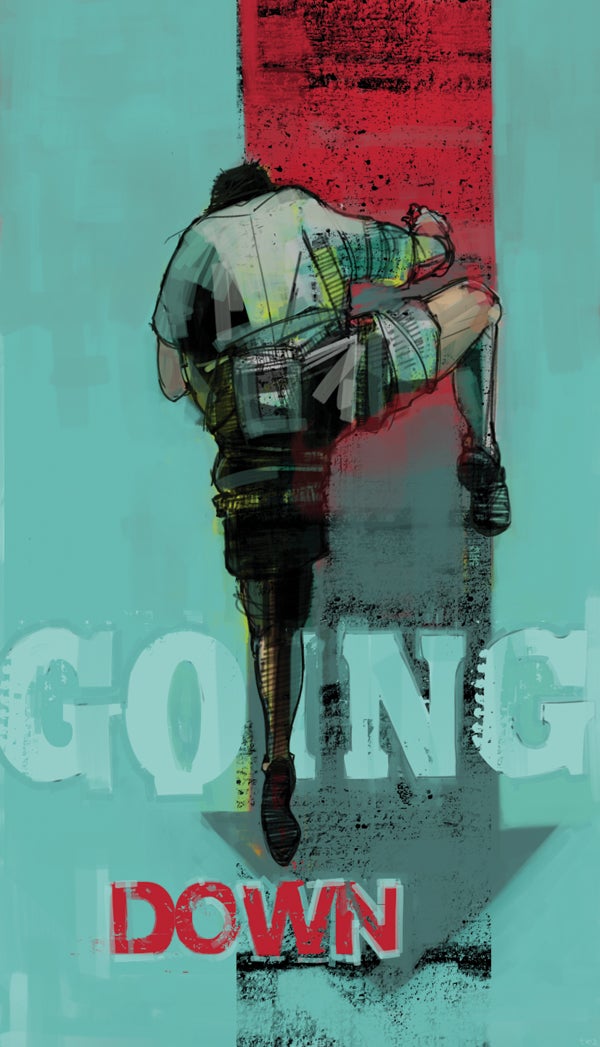Tech Tip - Trad - The Lost Art of Downclimbing

"DownclimbTT-268_10897.jpg"

Staying balance-neutral (and in control) on the return to EarthWhether it’s backing down a runout lead, navigating a sketchy descent, or merely exercising the unlikely (I will sometimes climb up and down the same route, just for fun!), the ability to downclimb (DC) is a skill worth polishing, especially for budding trad leaders. This hits with perspective from 100 years ago, when rock climbing meant soloing up, then down, whatever Dolomites objective loomed. I have a leading style that lets me move progressively higher, above rests, with my gear placements: on a difficult pitch, I’ll lead up, place protection, and then move back down to the rest (I’d rather reverse moves than take a big rip). I’ve also learned that being off route can be just as necky as a sick solo on a sketchy lead, you’ll need to consider reversibility on each move. Here’s how:Find Your CenterBefore you start down, find your physical center by assessing and establishing a Neutral Balance Point (NBP). This will entail getting into a comfortable stem, face position, or jam, with both feet at a similar height, such that gravity isn’t pulling you to one side. This NBP should offer the opportunity to forge a rest and calm down before you begin DC, and should be established wherever possible along your downclimb.Mental ShiftThe most effective safety tool in your arsenal is your brain so engage it with a decided push into DC mentality. First, alert your belayer with the positive “Watch me!”, not “I’m gonna fall!”; then think about how you got into your predicament. The first move back down is probably fresh in your memory, but take a deep breath and set your mental sights on your destination, as well. Will you have to DC nonstop all the way to the last piece, or is there a workable rest along the way? Finally, visualize every hold in the sequence at hand, making note of the best grips you’ll be looking for them.Technique Standing on your feet is just as important (yet surprisingly easier) on the way down as it is on the way up. Whether it’s having gravity in your favor or because your weight is shifted with such commitment, DC makes almost all footholds good. So watch for smears and edges that might have been “too small” on the way up. Leverage, layback, and opposition holds work great for DC, and “lowsteps” (reverse highsteps) are also reliable as you commit to leaning out. Get settled (remember your NBP) before reaching down for your next holds, and then simplify to the point where you’re smoothly making one hand move, and then one foot move, at a time.Body PositionAs you descend, don’t forget that the lockoff (hands on holds about chin height and elbows in, like a completed chin-up) and lockout (straight, extended arm, with weight borne by bone) positions burn the least muscle power. You’ll often have to compromise on these ideals, but be aware and minimize time spent in half-cocked arm positions. When leaning out to look for your next holds from an NBP lockoff, consider first lowering to a lockout, to extend visual range. Then return to a lockoff to regroup before continuing. In these transitions, picture yourself going from balanced on your feet and upright, to leaning out, to balanced again.Practice, PracticeNothing does like doing. If I’m indoors, I DC every route great for establishing eye-foot coordination. Sometimes, my perspective becomes myopic, and holds look farther away than they actually are. So I’m often surprised that foot moves which look like huge steps down are entirely reasonable once I start moving.Worst CaseHaving an attentive belayer will help the DC process. While it’s necessary for her to bring in rope while you descend, she needs to be additionally aware you might fall. While she can carefully pull in a few armlengths to lessen any lob, I prefer to have her lock the device off if I pitch, to avoid short-roping. As a leader, if you’re backcleaning on your way down, consider hanging on a piece to recoup physical or mental power. Gear should be considered expendable enough to warrant fashioning an improv anchor, to provide a toprope for your downclimb or even a lower-off. Never backclean below a single piece unless the situation absolutely demands DC off this one-point “anchor.”Mic Fairchild has spent 30 years on the rock long enough to go from “Gumby” to “Posable Gumby.” He holds the speed records both up (5:33) and down (10:42) Eldorado Springs Canyon’s Bastille Crack.